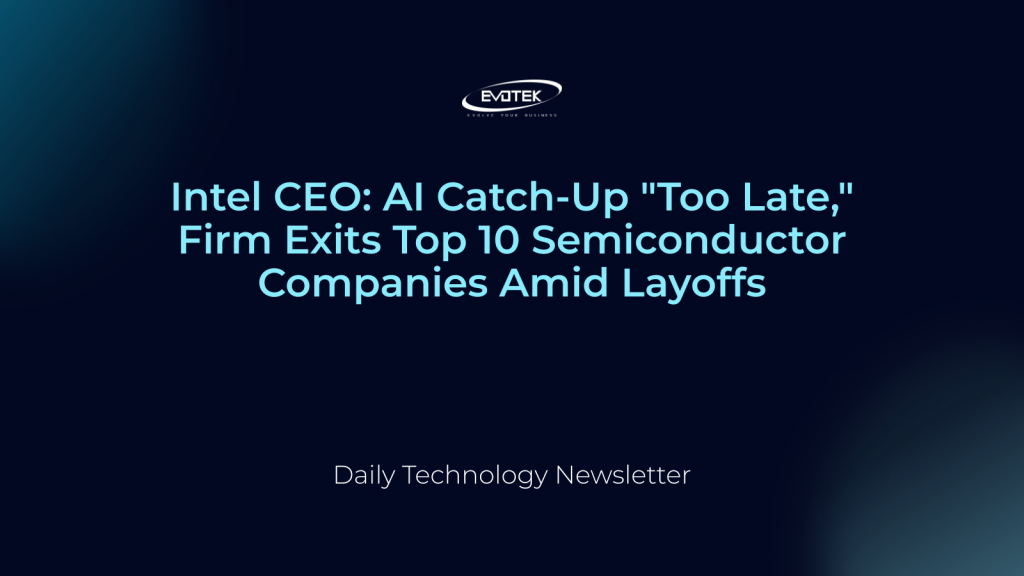The once-dominant Intel faces a challenging future, with its CEO reportedly admitting that the company is “too late” to catch up with competitors in the rapidly evolving artificial intelligence (AI) landscape. Furthermore, in a candid internal conversation, the CEO allegedly stated that Intel is no longer among the top 10 semiconductor companies globally, a stark contrast to its former industry leadership. These revelations surface as the tech giant implements global layoffs affecting thousands of employees.
Intel’s Recent Struggles and Market Position
For several years, Intel has grappled with significant setbacks. Its efforts to modernize the x86 architecture with a hybrid design have yielded limited market share gains, compounded by recent processor lineups struggling against AMD’s competitive offerings. In the GPU market, Intel’s Arc discrete graphics products were introduced late and, while showing potential, have fallen short of challenging dominant players like Nvidia.
According to leaked internal remarks reported by OregonTech, Lip-Bu Tan, Intel’s new CEO, underscored the company’s precarious position. Tan reportedly told employees: “Twenty, 30 years ago, we were really the leader. Now I think the world has changed. We are not in the top 10 semiconductor companies.” This admission marks a significant shift for a company that once held a near monopoly in the CPU market and even considered acquiring Nvidia, now valued at over $4 trillion.
The Rise of Competitors: AMD and Nvidia’s Dominance
Intel’s past struggles include underestimating AMD, which has since made substantial inroads. AMD’s Ryzen processors have gained considerable traction, and its chips now power popular handheld devices like the Steam Deck and Rog Ally X, as well as leading consoles such as the Xbox Series and PlayStation 5. Unlike Intel, AMD collaborates closely with TSMC, a leading chip manufacturer, for its fabrication needs.
In the burgeoning AI sector, Nvidia has established an almost unassailable lead, particularly with its data center GPUs that power the current era of machine learning, ushered in by innovations like OpenAI’s ChatGPT. This highlights another area where Intel failed to capitalize on its potential.
Manufacturing Challenges and Strategic Outsourcing
Historically, Intel’s integrated device manufacturing (IDM) model, where it designed and manufactured its own chips, was a core strength. However, recent faltering foundry nodes have become a liability, hindering its processor performance compared to TSMC’s prowess. Acknowledging this, Intel began outsourcing the GPU tile for its Meteor Lake chips to TSMC in 2023. This partnership expanded to include the entire compute tile for Lunar Lake, and by 2025, approximately 30% of Intel’s fabrication is expected to be handled by TSMC. This marks a crucial shift, indicating a realization that its internal foundry has been a limiting factor.
Cost-Cutting and a New AI Focus
The company’s substantial research and development (R&D) spending on future nodes, coupled with a reported $16 billion loss in Q3 last year, has necessitated aggressive cost-cutting measures, including the ongoing global layoffs. CEO Lip-Bu Tan emphasizes that Intel’s revitalization will be a “marathon,” demanding humility and responsiveness to industry demands.
Recognizing the insurmountable lead of Nvidia in AI training, Tan stated: “On training, I think it is too late for us.” Instead, Intel plans to pivot its focus towards edge AI, aiming to integrate AI processing directly into devices like PCs, reducing reliance on cloud-based computation. The company is also exploring agentic AI, where autonomous AI systems can operate without constant human intervention. Tan expressed optimism about recent high-profile hires and hinted at further talent acquisitions to bolster Intel’s position in these niche AI areas.
Leadership Transition and Future Vision
The leadership change, with Lip-Bu Tan replacing former CEO Pat Gelsinger, signals a more streamlined vision for Intel. Rather than concurrently focusing on multiple facets like CPU, GPU, and foundry operations, Tan aims to hone in on core competencies. This development aligns with persistent rumors of Intel potentially splitting into two entities, with its foundry business becoming an independent subsidiary, mirroring the fabless models of rivals like AMD and Apple. While this could offer Intel greater agility, it remains speculative as its crucial 18A manufacturing process is still a year away from full realization. The road ahead for Intel is undoubtedly long, requiring significant strategic adjustments to regain its competitive edge in the evolving semiconductor landscape.

 日本語
日本語 한국어
한국어 Tiếng Việt
Tiếng Việt 简体中文
简体中文